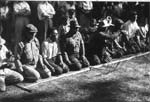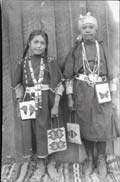 | | Stick Game at Kettle Falls, ca. 1939 |
The songs of the Schitsu'umsh express the heritage of the grandparents, and the values of family and sharing. They are acts of prayer and ceremony, to be used with great care. They can bring a laugh and a tear. For many families, the songs are what it means to be Schitsu'umsh. For it is the beat of the drum, in tandem with the voice of the song, that is the "heart beat of the people." Most certainly, the songs are much more than mere entertainment.
 | | One Team of Stick Game Players, ca. 1939 |
Songs are of all kinds and used for different purposes. Some songs are heard with voice, some are heard through the flute, and many are accompanied with the drum. Some songs are most revered and cherished, a person's own suumesh song. These are sung only during the sacred ceremonies, such as during a Sweat House ritual or Winter Jump Dance. When sung, the Animal Spirit is at hand to assist those in need. Some songs are sung by the hunters, just before they seek out an elk, and then, after success, during each stage of the butchering of the elk's flesh. It's a way to honor and show respect to the Elk. Some songs are sung with the rising of the sun, asking for a blessing for the family for that day. Special songs are sung during stick games, to "assure your side will be the winner." Some songs make up a large assemblage of songs heard during the social dances of a powwow. There are Honor Songs for the elders and veterans, or, perhaps, for the members of the high school state basketball championship team. During the powwow, there are songs for the traditional dancers, for the women's shawl and jingle dress dancers, for the grass and fancy dancers, for those in the round dance, and for those "just wanting to have fun."
The Indian flute has always played an important role in the life of the Schitsu'umsh. Like all songs, these songs were handed down from the grandparents, and all came from listening to the "voices" in the lakes, valleys and mountains. The following set of flute songs was a gift from Cliff SiJohn to you. He made these recordings in May of 1993. Use a FREE RealOne Player to access.
|
|
Listen as Cliff SiJohn considers "true heart songs" that come from the Sweat House and from the Animals. Part 10 of Interview; To begin the SiJohn Interview;
To continue the SiJohn Interview. (interviewed and edited by Rodney Frey, August 2002) |
 | | Lucy Daniel Finley and Mary Daniel Williams |
When a young Schitsu'umsh man once asked his grandpa where the songs come from, he told him the following. "The songs come from my dad and from my dad's dad, and from all our people, handed down from the beginning. When you go out and get your song, your suumesh, you have to listen to the Trees, you listen to Mother Earth; that's where you get your song from." When Coyote and Wolf and the other First Peoples prepared the world for the coming of the human peoples, they established the songs. The landscape is embedded with them to this day. Whether it was two hundred years ago or just last summer, when a young man or woman goes to a mountain summit to seek his or her guardian spirit, a suumesh song might be bestowed. An Animal Spirit has taken pity on the faster and will help protect him or her with the power of the song. For some, the songs are said to be the voices of one's guardian spirit. When age dictates it's time, an elder will then pass on to a grandson or granddaughter the song, to be passed in each of the generations to come.
© Coeur d'Alene Tribe 2002
< previous |
next >
|



